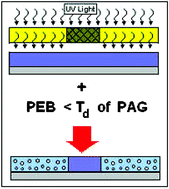UV-induced porosity using photogenerated acids to catalyze the decomposition of sacrificial polymers templated in dielectric films
Abstract
A UV-initiated process for selective incorporation of porosity and tuning of refractive index in a dielectric film is presented. The formation of porosity via radiation offers the advantages of lower processing temperatures and shorter processing times than most processes that rely on thermally-induced porosity. The ability to pattern porosity via the use of a photomask allows structures such as porous direct-write waveguides to be made. The direct-write process presented here used UV-generated acids to catalyze the decomposition of sacrificial polymers templated in a crosslinked matrix, resulting in the formation of porosity and decrease of refractive index and dielectric constant after subsequent removal of the generated acid. In unexposed areas, no acid molecules were generated, thus these areas remained non-porous and their refractive index remained relatively high compared to porous regions. Base-catalyzed


 Please wait while we load your content...
Please wait while we load your content...